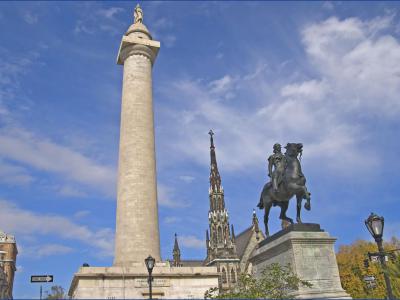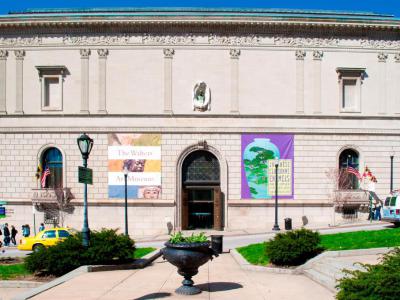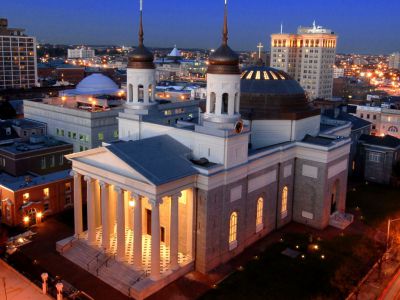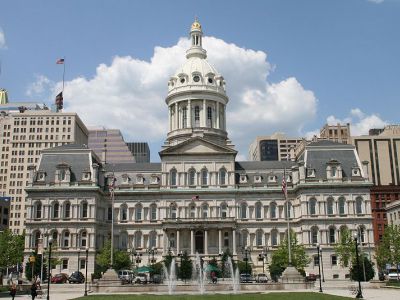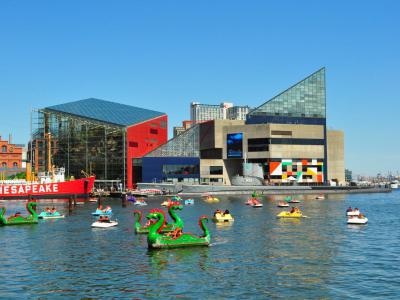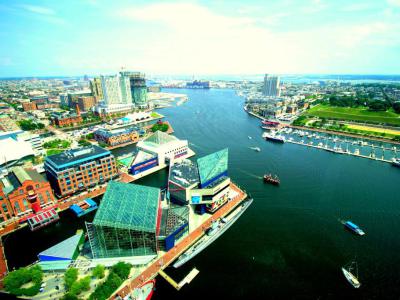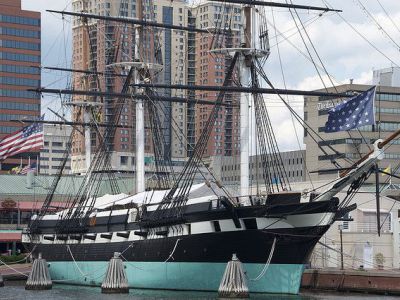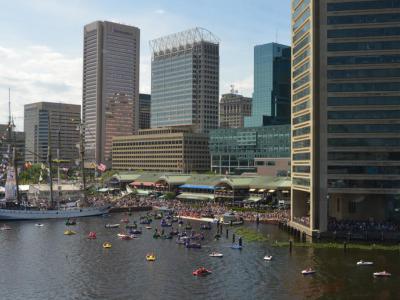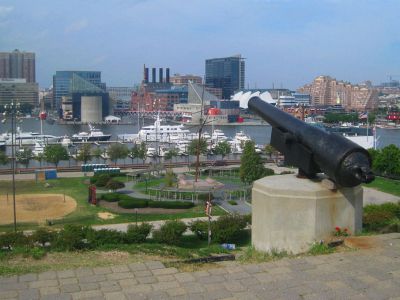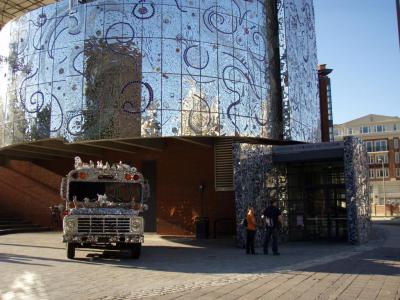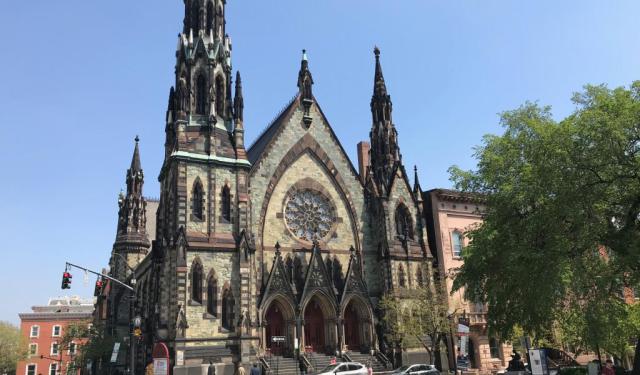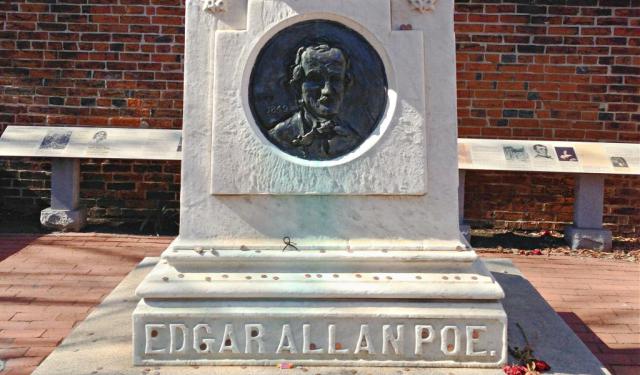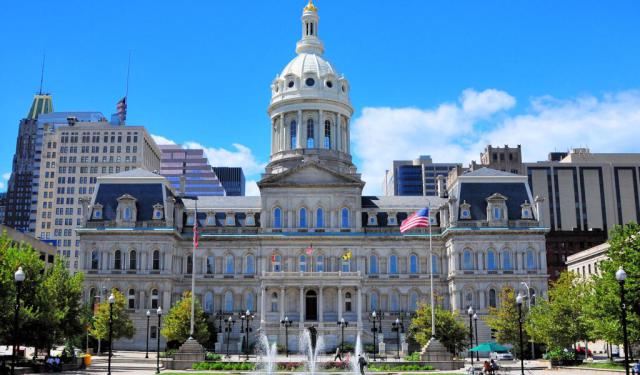
Baltimore Introduction Walking Tour (Self Guided), Baltimore
Baltimore is the largest city in Maryland. It is part of the Washington-Baltimore combined metropolitan area, making it a popular spot for those visitors who wish to see the city of Baltimore and the nation's capital. The city has a rich history in the founding of the United States.
Pre-colonization, the land that Baltimore now lies upon was inhabited by Paleo-Indians dating as far back as the 10th century BCE. However, it is thought to have been sparsely populated over the years. Most of the land was used as hunting grounds rather than permanent living space.
European colonization began in Baltimore in the early-17th century. The Susquehannock, who used the land for hunting, were strongly affected by diseases like smallpox that were brought from Europe. The English settlers then laid out streets, built structures, and developed the Port of Baltimore. This port was mostly used for the tobacco trade.
The Port of Baltimore saw warfare, especially during the War of 1812. It was during this war that the flag over Fort McHenry became the inspiration for the poem that would eventually become that national anthem, "The Star Spangled Banner."
The Great Baltimore Fire in 1904 destroyed many structures in the city. In part because of this fire, the city has a variety of architectural designs that make up some of its most important buildings. Among these are the Basilica of the Assumption, a neoclassical cathedral that was the first Roman Catholic cathedral in the United States.
Baltimore has a strong focus on tourism, with many spots catered for visitors who want to learn more about the city, its history, and its art scene. The USS Constellation is a particularly popular attraction as it is the only surviving, intact vessel from the U.S. Civil War. The National Aquarium in Baltimore is the most visited tourist attraction in the state, with more than 750 species. The Top of the World Observation Level and Museum includes a 360-degree view of the city along with a 9/11 memorial museum.
Take this self-guided walking tour to see some of the most notable sights in Baltimore.
Pre-colonization, the land that Baltimore now lies upon was inhabited by Paleo-Indians dating as far back as the 10th century BCE. However, it is thought to have been sparsely populated over the years. Most of the land was used as hunting grounds rather than permanent living space.
European colonization began in Baltimore in the early-17th century. The Susquehannock, who used the land for hunting, were strongly affected by diseases like smallpox that were brought from Europe. The English settlers then laid out streets, built structures, and developed the Port of Baltimore. This port was mostly used for the tobacco trade.
The Port of Baltimore saw warfare, especially during the War of 1812. It was during this war that the flag over Fort McHenry became the inspiration for the poem that would eventually become that national anthem, "The Star Spangled Banner."
The Great Baltimore Fire in 1904 destroyed many structures in the city. In part because of this fire, the city has a variety of architectural designs that make up some of its most important buildings. Among these are the Basilica of the Assumption, a neoclassical cathedral that was the first Roman Catholic cathedral in the United States.
Baltimore has a strong focus on tourism, with many spots catered for visitors who want to learn more about the city, its history, and its art scene. The USS Constellation is a particularly popular attraction as it is the only surviving, intact vessel from the U.S. Civil War. The National Aquarium in Baltimore is the most visited tourist attraction in the state, with more than 750 species. The Top of the World Observation Level and Museum includes a 360-degree view of the city along with a 9/11 memorial museum.
Take this self-guided walking tour to see some of the most notable sights in Baltimore.
How it works: Download the app "GPSmyCity: Walks in 1K+ Cities" from Apple App Store or Google Play Store to your mobile phone or tablet. The app turns your mobile device into a personal tour guide and its built-in GPS navigation functions guide you from one tour stop to next. The app works offline, so no data plan is needed when traveling abroad.
Baltimore Introduction Walking Tour Map
Guide Name: Baltimore Introduction Walking Tour
Guide Location: USA » Baltimore (See other walking tours in Baltimore)
Guide Type: Self-guided Walking Tour (Sightseeing)
# of Attractions: 10
Tour Duration: 2 Hour(s)
Travel Distance: 3.6 Km or 2.2 Miles
Author: Caroline
Sight(s) Featured in This Guide:
Guide Location: USA » Baltimore (See other walking tours in Baltimore)
Guide Type: Self-guided Walking Tour (Sightseeing)
# of Attractions: 10
Tour Duration: 2 Hour(s)
Travel Distance: 3.6 Km or 2.2 Miles
Author: Caroline
Sight(s) Featured in This Guide:
- Washington Monument and Museum at Mount Vernon Place
- Walters Art Museum
- Basilica of the Assumption
- Baltimore City Hall
- National Aquarium in Baltimore
- Top of the World Observation Level and Museum
- U.S.S. Constellation
- Inner Harbor Waterfront Promenade
- Federal Hill Park
- American Visionary Art Museum
1) Washington Monument and Museum at Mount Vernon Place
The Washington Monument at Mount Vernon Place was the first significant monument built in honor of President George Washington. Construction on the memorial began in 1815 and was completed in 1829.
The monument was designed by a famed architect Robert Mills who also designed the Washington Monument in Washington, D.C. The Washington Monument in Baltimore is a marble, Doric column that is 178 feet high. There are 227 steps to climb to the top of the monument tower to look through a viewing window.
A statue of George Washington, carved by sculptor Enrico Causici, stands atop the monument. Other details include bronze inscriptions that describe Washington's life and career. These plaques were added with the advisement of John Quincy Adams.
The museum is located on the ground floor of the monument. It contains digital exhibits detailing the construction process, the history of Mount Vernon, and the life of George Washington.
The monument was designed by a famed architect Robert Mills who also designed the Washington Monument in Washington, D.C. The Washington Monument in Baltimore is a marble, Doric column that is 178 feet high. There are 227 steps to climb to the top of the monument tower to look through a viewing window.
A statue of George Washington, carved by sculptor Enrico Causici, stands atop the monument. Other details include bronze inscriptions that describe Washington's life and career. These plaques were added with the advisement of John Quincy Adams.
The museum is located on the ground floor of the monument. It contains digital exhibits detailing the construction process, the history of Mount Vernon, and the life of George Washington.
2) Walters Art Museum (must see)
Walters Art Museum, locally known simply as "The Walters," is an art museum that focuses primarily on the works of American artists. It also contains art from ancient Egypt, Greece, and Rome. The remarkable permanent collection features ancient Asian art, textiles, furniture, jewelry, arms, and armor.
The museum was established by collectors, father and son William Thompson Walters and Henry Walters, in the late-19th century. The collection was given to the City of Baltimore in 1931 upon the death of Henry Walters.
The Egyptian collection includes two statues of the goddess Sehkmet and the Walters Mummy. The Roman collection offers portrait heads, a banquet couch, and marble sarcophagi from the tombs of the Licinian and Calpurnian families.
Artwork ranges from across the globe; the significant focus is on pottery and stone from the Americas. Fine art held in the museum varies from the late Medieval works of Italian artists Ciccarello and Lorenzetti to the Renaissance works of Greek painter El Greco. Pieces from Monet, Manet, and Rousseau are among those found in the museum. Two Faberge eggs are among the jeweled items on display.
The Walters Museum offers free admission to all visitors.
The museum was established by collectors, father and son William Thompson Walters and Henry Walters, in the late-19th century. The collection was given to the City of Baltimore in 1931 upon the death of Henry Walters.
The Egyptian collection includes two statues of the goddess Sehkmet and the Walters Mummy. The Roman collection offers portrait heads, a banquet couch, and marble sarcophagi from the tombs of the Licinian and Calpurnian families.
Artwork ranges from across the globe; the significant focus is on pottery and stone from the Americas. Fine art held in the museum varies from the late Medieval works of Italian artists Ciccarello and Lorenzetti to the Renaissance works of Greek painter El Greco. Pieces from Monet, Manet, and Rousseau are among those found in the museum. Two Faberge eggs are among the jeweled items on display.
The Walters Museum offers free admission to all visitors.
3) Basilica of the Assumption
The Basilica of the Assumption, referred to as the Baltimore Basilica, is a Roman Catholic Church. It was the first Roman Catholic cathedral built in the United States and was among the first religious buildings constructed after the adoption of the U.S. Constitution. It was consecrated on May 31, 1821.
Construction on the Baltimore Basilica began in 1806. Architect Benjamin Henry Latrobe, known as "the Father of American Architecture," designed the building in the Neoclassical style with guidance from John Carroll, the first American bishop of the Roman Catholic church.
The cathedral is noted for its onion-shaped dome. The interior has many works of fine art, including two that were gifted to the basilica by King Louis XVIII of France.
The Basilica of the Assumption is on the U.S. National Register of Historic Places and is considered a U.S. National Historic Landmark.
Construction on the Baltimore Basilica began in 1806. Architect Benjamin Henry Latrobe, known as "the Father of American Architecture," designed the building in the Neoclassical style with guidance from John Carroll, the first American bishop of the Roman Catholic church.
The cathedral is noted for its onion-shaped dome. The interior has many works of fine art, including two that were gifted to the basilica by King Louis XVIII of France.
The Basilica of the Assumption is on the U.S. National Register of Historic Places and is considered a U.S. National Historic Landmark.
4) Baltimore City Hall
Baltimore City Hall is the seat of government for Baltimore. It houses the offices of the Mayor, the city council, and other government officials.
The building was designed by a 22-year-old architect, George A. Frederick, in the Second Empire architectural style. The engineer Wendel Bollman designed the city hall's dome and cast iron roof. Construction began in 1867 and was completed in 1875.
The six-story edifice was the first building constructed solely for the city's government. Before its construction, city leaders met in the Maryland Insurance Company building, the Baltimore Dancing Assembly, the Baltimore Exchange Company, and Peale's Baltimore Museum and Gallery of Fine Arts.
The City Hall fell under disrepair after the end of World War II. After 15 pounds of iron collapsed from the iron dome into the Board of Estimates hearing room, a decision was made to renovate the building. Two additional floors were added, which doubled the usable space in the building.
Baltimore City Hall is designated as a Baltimore City Landmark; is on the U.S. National Register of Historic Places.
The building was designed by a 22-year-old architect, George A. Frederick, in the Second Empire architectural style. The engineer Wendel Bollman designed the city hall's dome and cast iron roof. Construction began in 1867 and was completed in 1875.
The six-story edifice was the first building constructed solely for the city's government. Before its construction, city leaders met in the Maryland Insurance Company building, the Baltimore Dancing Assembly, the Baltimore Exchange Company, and Peale's Baltimore Museum and Gallery of Fine Arts.
The City Hall fell under disrepair after the end of World War II. After 15 pounds of iron collapsed from the iron dome into the Board of Estimates hearing room, a decision was made to renovate the building. Two additional floors were added, which doubled the usable space in the building.
Baltimore City Hall is designated as a Baltimore City Landmark; is on the U.S. National Register of Historic Places.
5) National Aquarium in Baltimore (must see)
The National Aquarium in Baltimore is a 250,000-square-foot aquarium. It has over 17,000 animals of more than 750 species. With more than 1.5 million visitors per year, it is the most visited tourist attraction in Maryland.
The aquarium offers many different exhibitions. These include an exhibit that features the Atlantic coral reef, a tropical rainforest, Australia's unique marine life, and an open-ocean shark tank. The National Aquarium also has a 4D theatre with daily, rotating shows.
The aquarium features special events that guests can add to the aquarium experience. These special events include behind-the-scenes tours, dolphin training, guest diving, and family sleepovers.
The National Aquarium, founded in 1978, officially opened as a national marine exhibit in 1981. It was designed by architect Peter Chermayeff. The Glass Pavilion expansion, added in 2005, was designed by Bobby C. Poole.
The Glass Pavilion is a five-level building. The first level is called the Blacktip Reef. It has a 265,000-gallon tank with 69 species of fish, including the blacktip reef shark. The second level, Maryland: Mountains to the Sea, shows animals that are indigenous to Maryland, like the wood turtle and the American bullfrog.
The third level of the Glass Pavilion shows sea life that has evolved over the years, like the electric eel. Level four features the Amazon River and the Pacific coral reef. Birds like Atlantic puffins and snakes like emerald tree boas can be seen here. The final level is the Tropical Rain Forest, which offers several different animals like the scarlet ibis, the yellow-headed amazon parrot, the blue poison dart frog, and Linnaeus's two-toed sloth.
The aquarium focuses strongly on conservation. Nearly half of the power for the marine exhibit comes from a solar farm. The National Aquarium Conservation Center was established in 2009 to research improving coastal ecosystems, aquaculture, and watersheds.
The aquarium offers many different exhibitions. These include an exhibit that features the Atlantic coral reef, a tropical rainforest, Australia's unique marine life, and an open-ocean shark tank. The National Aquarium also has a 4D theatre with daily, rotating shows.
The aquarium features special events that guests can add to the aquarium experience. These special events include behind-the-scenes tours, dolphin training, guest diving, and family sleepovers.
The National Aquarium, founded in 1978, officially opened as a national marine exhibit in 1981. It was designed by architect Peter Chermayeff. The Glass Pavilion expansion, added in 2005, was designed by Bobby C. Poole.
The Glass Pavilion is a five-level building. The first level is called the Blacktip Reef. It has a 265,000-gallon tank with 69 species of fish, including the blacktip reef shark. The second level, Maryland: Mountains to the Sea, shows animals that are indigenous to Maryland, like the wood turtle and the American bullfrog.
The third level of the Glass Pavilion shows sea life that has evolved over the years, like the electric eel. Level four features the Amazon River and the Pacific coral reef. Birds like Atlantic puffins and snakes like emerald tree boas can be seen here. The final level is the Tropical Rain Forest, which offers several different animals like the scarlet ibis, the yellow-headed amazon parrot, the blue poison dart frog, and Linnaeus's two-toed sloth.
The aquarium focuses strongly on conservation. Nearly half of the power for the marine exhibit comes from a solar farm. The National Aquarium Conservation Center was established in 2009 to research improving coastal ecosystems, aquaculture, and watersheds.
6) Top of the World Observation Level and Museum (must see)
The Top of the World Observation Level is a viewing area on the 27th floor of the World Trade Center. It offers views of the Baltimore skyline and inner harbor.
The Observation Level is fully enclosed. It offers a 360-degree panoramic view, art exhibits, and an exhibit on the city's history. The Top of the World Observation Level also hosts the 9/11 Memorial of Maryland.
Baltimore World Trade Center is the world's tallest pentagonal building. The 30-floor structure 405 feet high was completed in 1977. The building was designed by the firm of the famous architect I.M. Pei (Pei Cobb Freed & Partners,) with the principal architects being Henry Cobb and Pershing Wong.
The Top of the World Observation Level is operated by the Baltimore Office of Promotion and the Arts. The non-profit organization provides support to artists and art programs across Baltimore.
The Top of the World Observation Level is open Wednesday through Sunday. Large groups can schedule private tours of the Observation Level on Mondays and Tuesdays.
The Observation Level is fully enclosed. It offers a 360-degree panoramic view, art exhibits, and an exhibit on the city's history. The Top of the World Observation Level also hosts the 9/11 Memorial of Maryland.
Baltimore World Trade Center is the world's tallest pentagonal building. The 30-floor structure 405 feet high was completed in 1977. The building was designed by the firm of the famous architect I.M. Pei (Pei Cobb Freed & Partners,) with the principal architects being Henry Cobb and Pershing Wong.
The Top of the World Observation Level is operated by the Baltimore Office of Promotion and the Arts. The non-profit organization provides support to artists and art programs across Baltimore.
The Top of the World Observation Level is open Wednesday through Sunday. Large groups can schedule private tours of the Observation Level on Mondays and Tuesdays.
7) U.S.S. Constellation
The USS Constellation is the last sail-only warship built by the United States Navy and the last intact naval ship from the U.S. Civil War. The sloop-of-war was built between 1853 and 1855. The construction used material salvaged from the disassembled frigate USS Constellation.
The ship is now a functioning museum in Baltimore's Inner Harbor, moored at Constellation Dock. The USS Constellation is part of the Historic Ships in Baltimore. Other Historic Ships in Baltimore include a Coast Guard cutter, a World War II submarine, the Seven Foot Knoll Light, and the lightship Chesapeake.
Visitors to the USS Constellation may attend the ship's museum gallery at Pier 1 in the Inner Harbor. Patrons can participate in a Parrott rifle drill, experience a tour and speak with a crew member about the ship and its history. Aboard, four decks are restored to represent the same appearance from her days serving in the Civil War.
The museum included about 50,000 artifacts, mainly documents, and photographs. Personal items have been donated by the descendants of former crew members.
The ship is now a functioning museum in Baltimore's Inner Harbor, moored at Constellation Dock. The USS Constellation is part of the Historic Ships in Baltimore. Other Historic Ships in Baltimore include a Coast Guard cutter, a World War II submarine, the Seven Foot Knoll Light, and the lightship Chesapeake.
Visitors to the USS Constellation may attend the ship's museum gallery at Pier 1 in the Inner Harbor. Patrons can participate in a Parrott rifle drill, experience a tour and speak with a crew member about the ship and its history. Aboard, four decks are restored to represent the same appearance from her days serving in the Civil War.
The museum included about 50,000 artifacts, mainly documents, and photographs. Personal items have been donated by the descendants of former crew members.
8) Inner Harbor Waterfront Promenade (must see)
The Inner Harbor Waterfront Promenade is an eight-mile pedestrian walkway and bicycle path. It provides access to the views of the Patapsco River harbor and the many shops, dining areas, entertainment, and public spaces near the promenade.
The Inner Harbor Waterfront Promenade offers access to multiple museums and attractions. The most popular attraction is the National Aquarium, which is not only the most widely visited aquarium along the pedestrian walkway but also the most highly trafficked tourist attraction in Maryland.
Another favored museum with access to the promenade is the USS Constellation. The restored naval vessel is the only surviving, intact ship from the Civil War. Other places of interest along the promenade include the Maryland Science Center and Port Discovery Children's Museum.
There are many attractive spots for photo opportunities along the Inner Harbor Waterfront Promenade. Tourists should check out the Mr. Trash Wheel Sculpture, which serves double duty as a fun work of art and a trash-collecting vessel. Seven Foot Knoll Lighthouse, the Top of the World Observation Level, and the Pride of Baltimore Memorial are worth visiting.
The Inner Harbor Waterfront Promenade offers access to multiple museums and attractions. The most popular attraction is the National Aquarium, which is not only the most widely visited aquarium along the pedestrian walkway but also the most highly trafficked tourist attraction in Maryland.
Another favored museum with access to the promenade is the USS Constellation. The restored naval vessel is the only surviving, intact ship from the Civil War. Other places of interest along the promenade include the Maryland Science Center and Port Discovery Children's Museum.
There are many attractive spots for photo opportunities along the Inner Harbor Waterfront Promenade. Tourists should check out the Mr. Trash Wheel Sculpture, which serves double duty as a fun work of art and a trash-collecting vessel. Seven Foot Knoll Lighthouse, the Top of the World Observation Level, and the Pride of Baltimore Memorial are worth visiting.
9) Federal Hill Park
Federal Hill Park is a public park near Baltimore's Inner Harbor. The 10.3-acre park offers spectacular views of the harbor and the downtown skyline.
The park, created in 1880, was named for the hill and the nearby Federal Hill neighborhood. Before being a public park, the area was used by the Union Army during the U.S. Civil War as Fort Federal Hill.
The hill has not always been a treasured area in the city. Even after being declared a public park, it was graded for its red clay. As a result, massive erosion on the hill has caused its collapse on two occasions. The area was re-stabilized in 1995 and 2000.
Visitors to the park will see cannons used during the Civil War. They will also find recreational areas, including a basketball court, beach volleyball, and playground. The hill is often used for picnics during the day and for stargazing at night.
The park, created in 1880, was named for the hill and the nearby Federal Hill neighborhood. Before being a public park, the area was used by the Union Army during the U.S. Civil War as Fort Federal Hill.
The hill has not always been a treasured area in the city. Even after being declared a public park, it was graded for its red clay. As a result, massive erosion on the hill has caused its collapse on two occasions. The area was re-stabilized in 1995 and 2000.
Visitors to the park will see cannons used during the Civil War. They will also find recreational areas, including a basketball court, beach volleyball, and playground. The hill is often used for picnics during the day and for stargazing at night.
10) American Visionary Art Museum (must see)
The American Visionary Art Museum, or AVAM, is an art museum that specializes in outsider art. The permanent collection has about 4,000 pieces spread over three floors of exhibition space.
The museum was established in 1995. The land was given to the museum by the city in exchange for an agreement that the museum's organizers would clear pollution from the copper factory and warehouse that had previously been on the site.
Visionary artists featured at the American Visionary Art Museum include Ho Baron, Nek Chand, Howard Finster, Vanessa German, Leo Sewell, Judith Scott, and Leonard Knight. Along with the artwork on display, the museum has a wildflower garden and a sculpture barn.
AVAM hosts an event called "Flicks from the Hill." The Hughes Family Outdoor Theater seats over 1,000 people who gather to watch movies during the summer film series. The movies vary but are always related to the museum's current exhibit.
The museum was established in 1995. The land was given to the museum by the city in exchange for an agreement that the museum's organizers would clear pollution from the copper factory and warehouse that had previously been on the site.
Visionary artists featured at the American Visionary Art Museum include Ho Baron, Nek Chand, Howard Finster, Vanessa German, Leo Sewell, Judith Scott, and Leonard Knight. Along with the artwork on display, the museum has a wildflower garden and a sculpture barn.
AVAM hosts an event called "Flicks from the Hill." The Hughes Family Outdoor Theater seats over 1,000 people who gather to watch movies during the summer film series. The movies vary but are always related to the museum's current exhibit.
Walking Tours in Baltimore, Maryland
Create Your Own Walk in Baltimore
Creating your own self-guided walk in Baltimore is easy and fun. Choose the city attractions that you want to see and a walk route map will be created just for you. You can even set your hotel as the start point of the walk.
Baltimore's Architectural Jewels
Overall, Baltimore's architecture is a testament to the city's rich and varied history, showcasing a wide range of styles and cultural influences that have shaped the local built environment over the centuries. Outside Federal-style row houses and grand Beaux-Arts museums, Baltimore is also known for a multitude of Art Deco buildings and temples of various styles, constructed between the... view more
Tour Duration: 2 Hour(s)
Travel Distance: 3.9 Km or 2.4 Miles
Tour Duration: 2 Hour(s)
Travel Distance: 3.9 Km or 2.4 Miles
Edgar Allan Poe’s Baltimore
Edgar Allan Poe was a great American writer of short stories and poems. His works, from "The Raven" to "The Tell-Tale Heart," have inspired generations. Devotees of Edgar Allan Poe will find many mesmerizing spots in Edgar Allan Poe's Baltimore.
Poe moved to Baltimore for the first time in 1829 and left shortly thereafter. He returned in 1831 and wrote many poems and... view more
Tour Duration: 2 Hour(s)
Travel Distance: 5.5 Km or 3.4 Miles
Poe moved to Baltimore for the first time in 1829 and left shortly thereafter. He returned in 1831 and wrote many poems and... view more
Tour Duration: 2 Hour(s)
Travel Distance: 5.5 Km or 3.4 Miles
The Most Popular Cities
/ view all
